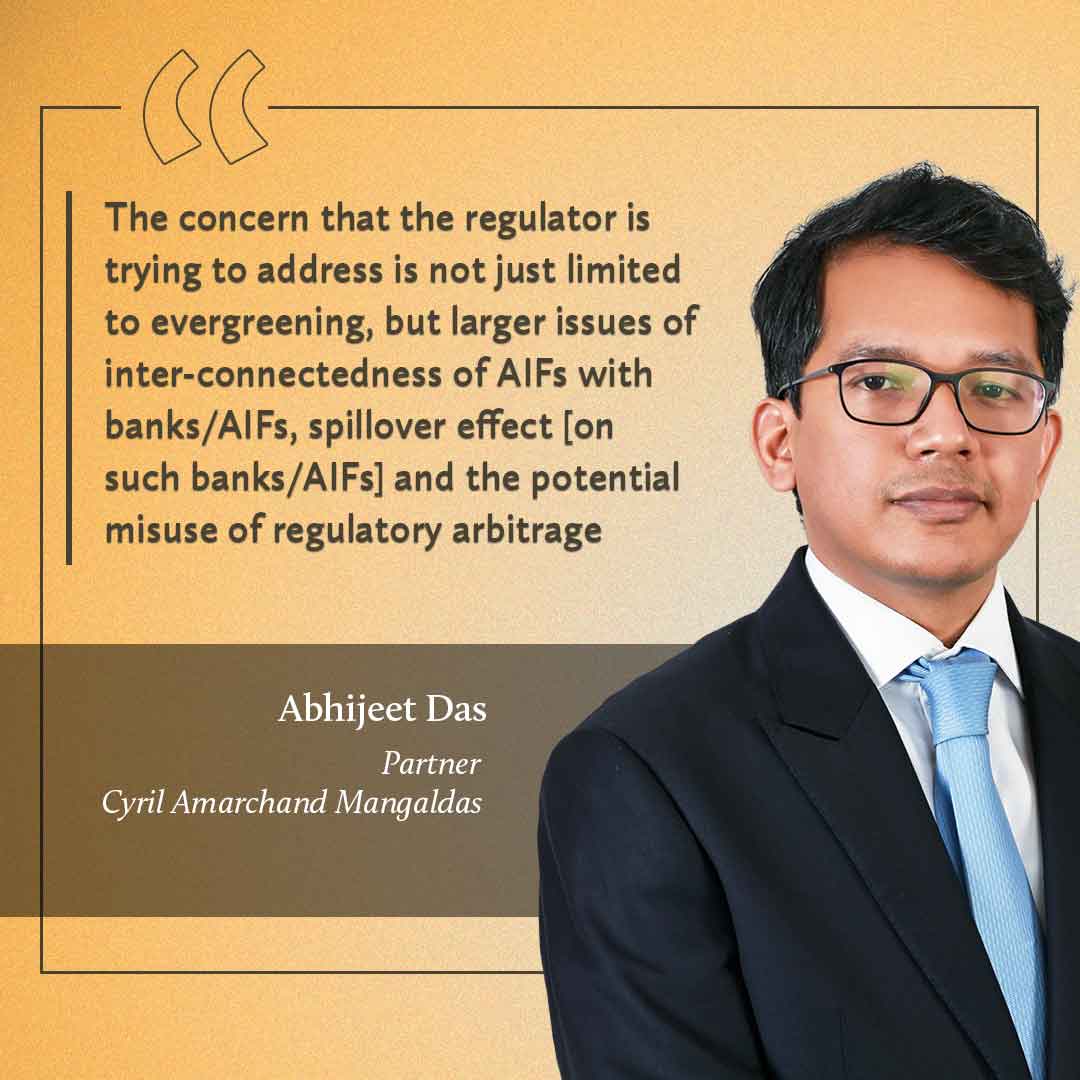The central bank’s move to curb evergreening loans looks set to backfire as the future of alternative investment funds may hang in the balance, writes Freny Patel
Many non-bank finance companies (NBFCs) are running pillar-to-post in a major attempt to transfer or sell their holdings in alternative investment funds (AIFs). Most of their attempts have either been futile or come at a huge cost as investors demand sizeable discounts, industry sources tell India Business Law Journal.
The plight of NBFCs stems from a central bank directive to “regulated entities” to forgo investing in AIFs should the downstream investments be in a debtor company of the regulated entity. Regulated entities, such as banks and NBFCs that have already invested in AIFs, have been given 30 days to assess their investee AIFs’ portfolios and liquidate their investment in the AIFs, or else make 100% provisioning.
“This poses major challenges for NBFCs and banks, as the transfer of units is highly restrictive. India’s secondary market for AIF units is still at a nascent stage of growth, with few takers having the ability to absorb the units of regulated entities,” explains Vivaik Sharma, a Mumbai-based partner at Cyril Amarchand Mangaldas (CAM).
“This means most regulated entities with exposure to AIFs may have to make 100% provisioning, which adds to their financial cost,” he says.
The Reserve Bank of India (RBI) ended 2023 with a strong warning to prevent regulated entities from misusing AIFs to hide evergreening loans and unrecognised non-performing assets.
The RBI directive was motivated by a consultation paper issued by the Securities and Exchange Board of India (SEBI) in May 2023, in which the capital market watchdog identified certain structures that could be used for the “evergreening” of loans by regulated entities.
“Evergreening” involves extending a new loan to a borrower to help repay an existing loan. Evergreening contributes to systemic financial risks and long-term asset deterioration.
While the RBI’s intention to stop banks and NBFCs from misusing AIFs to evergreen their loan portfolios is valid, a ban on investments in AIFs with downstream investments in debtor companies appears to imply that all such investments are a form of “evergreening”.
It is not surprising, therefore, that investors are now suspicious of whether the AIF investments were made to bypass regulations, as several banks and NBFCs in particular ran into a wall when seeking buyers for their AIF investment portfolios, Roopal Bajaj, Singhania & Co’s New Delhi-based Funds and Private Client leader, tells IBLJ.
More than just evergreening
“The concern that the regulator is trying to address is not just limited to evergreening, but larger issues of inter-connectedness of AIFs with banks/AIFs, spillover effect [on such banks/AIFs] and the potential misuse of regulatory arbitrage,” says Abhijeet Das, a Mumbai-based partner at CAM.
While the RBI circular states evergreening is a concern to be addressed, the intent behind it seems to be broader.
Das cites the RBI’s Financial Stability Report, issued in December 2023, which highlights the regulatory concerns over the growing interlinkages of AIFs with traditional providers of capital such as banks and NBFCs, spillover effects, and the potential for misuse of regulatory arbitrage between the different funding platforms.
“It seems that the regulator wants banks/NBFCs to assess the route under which they take exposures on borrowers – that is, through their balance sheet or indirectly through AIFs in which they are invested,” says Das.
The RBI probably needs to get comfortable with banks investing in AIFs, says Kumar Saurabh Singh, a Mumbai-based partner in the banking and finance practice at Khaitan & Co. “The RBI seems concerned that the lending and the restructuring norms may not have been followed in some cases,” he says.
To address the RBI’s evergreening concerns, Nandini Pathak, a leader at the Investment Funds Practice at Nishith Desai Associates in Mumbai, suggests increased disclosure requirements and transparency guidelines may deter evergreening via AIFs.
“Preventing the issuance of subordinate units to regulated entities by the AIF when the portfolio consists of debtor companies is also a practical and commercially relevant way of preventing evergreening,” says Pathak.
Singh, of Khaitan & Co, says the real test for banks and NBFCs is to demonstrate that AIFs are an investment tool, and are not being used to solve exposure to borrowers.
RBI diktat backfires?
While the aim may be to avert systemic risks in the financial services sector, the RBI directive has raised concerns in the industry about the effectiveness of balancing risk mitigation, as it could hinder the growth of India’s financial services sector and hurt the entire AIF ecosystem.
The foremost challenge has been the lack of practicable options for regulated entities to prevent being non-compliant with the instructions, says Pathak. The timelines given for compliance are aggressive and the instructions overreaching, she adds. “While the intent seems to be to prevent substitution of direct loan exposure to indirect exposure through AIFs, the instructions even cover investee companies, which have equity investment from these regulated companies.”
Pathak says provisioning is commercially onerous for regulated entities and is becoming difficult for banks and NBFCs to implement.
Singh says that provisioning based on actual requirements will have practical problems. “As banks undertake quarterly assessments, they will also have to monitor how an AIF is investing,” he says. Following the RBI circular, AIFs will equally be careful not to invest in companies where banks and NBFCs already have exposure, he adds.
The industry has seen affected investors requesting to be excused from all future investments being made by the AIF.
Singhania’s Bajaj warns that where financial institutions have committed future investments in a particular AIF, they may now have to pay a penalty and will not be permitted to take part in future transactions.
Some players may seek to transfer their holdings to group entities or try offloading such investments. However, Pathak points out that the latter option is proving increasingly difficult, as the Indian secondary market for AIF investments is quite small and highly illiquid. “Further, any such transfers would most likely be at steep discounts,” she says.
According to an insider, a prominent NBFC was able to sell just 40% of its AIF portfolio at par. It faced difficulties in selling the remaining 20% of the portfolio, and sold it at a significant discount. As a result, the NBFC is now stuck with the balance of 20% of the portfolio and will be required to provision for it.
Provisioning is a cost for NBFCs, as they will need to borrow additional funds from the market at a rate of 8% to 8.5%. This means the cost of capital for an NBFC will increase to more than 16%, against a return on investment in its AIF portfolio of about 10.25%, an insider says.
Considering India’s secondary market for AIF units is still nascent, with few takers being able to absorb the units of regulated entities, the transfer of units is highly restrictive. “This means most regulated entities with exposure to AIFs may have to make 100% provisioning, which adds to their financial cost,” says CAM’s Sharma.
Pathak says that the transfer of AIF units at a discount invites potential tax implications. “If the AIF units are sold at a discount that is below fair market value, then under section 56(2)(x) of the Income Tax Act, 1961, the difference between the fair market value and the acquisition price will be taxable at the hands of the buyer as income from other sources,” she explains.
In the future, banks and NBFCs may be more reluctant to invest in AIFs, which the industry fears will hurt existing investments, and also harm AIFs.
Banks cannot invest more than 10% of their corpus in AIFs. Bajaj does not rule out the possibility of some banks investing less than the limit in future, and the RBI’s imposing similar caps for NBFCs.
The high cost of structuring a debt transaction could deter regulated entities.
Banks and NBFCs will lose out on the exponential growth and capital appreciation of startups, which are generally funded through AIFs. Private investors and foreign institutional investors will end up benefiting at the expense of banks and NBFCs.
AIFs’ future in jeopardy
As the RBI’s December circular was implemented retroactively, life has become challenging for AIF managers. “It is difficult to quantify the impact or consequences of RBI’s retroactive action,” says one AIF manager. To minimise the impact on existing investments, the AIF industry has sought clarity from the RBI, he adds.
This is because the 30-day liquidation rule will freeze investments and domestic capital flow in AIFs, points out a second AIF manager.
Sharma says: “As the RBI has prohibited any future investments – including unfunded commitments – in AIFs that have invested in borrowers or investees of the regulated entities, managers of these AIFs may find it difficult to honour future funding obligations due to the reduction in AIFs’ investable corpus.”
Given the illiquidity of AIF units, banks and NBFCs wanting to exit their portfolios will not find it easy, or feasible. The RBI through its circular has implied the same, stating that should the regulated entities not sell or transfer their AIF units, they will have to make adequate provisioning for their entire AIF exposure.
The RBI diktat imposes several difficulties for AIFs. There may be cases where an AIF has already committed to invest in a company based on the entire corpus available but, given the RBI directive, there will be shrinkage of the corpus as regulated entities cease to contribute additional funds to the AIF.
Sharma anticipates the AIF ecosystem will see broken deals and associated costs. AIFs will find difficulties in fundraising because many investors are regulated entities, he says, pointing to the increased reliance on foreign institutional capital.
Regulated entities today form one of the largest sources of domestic contributions to AIFs. “On one hand, there are efforts by the regulators and the government to promote unlocking of domestic capital, but on the other hand, restrictions such as these would lead to further locking of the domestic capital, and increase in demand for foreign capital,” says Pathak.
It is not just the RBI that has expressed concerns about the use of AIFs by regulated entities for evergreening. The SEBI, in its consultation paper on 19 January 2024, highlighted similar concerns. It has sought assurance from AIFs that investments do not breach regulations. The capital market watchdog said it had detected at least 40 cases involving assets under management exceeding INR300 billion (USD3.62 billion) where the use of AIFs breached financial regulations.
RBI out of step with SEBI
Banks and NBFCs have written to the RBI seeking clarity, given the stringent 30-day timeline when liquidation is not practical or possible because of the SEBI’s strict regulations, says Bajaj. “The RBI diktat has not married with SEBI regulations.”
Among AIFs, there have been a few cases where financial institutions are the key sponsors and hence require SEBI permission to sell their stakes to new sponsors, she says. “Such a change is not seen favourably by the SEBI. Where financial institutions have committed future investments in a particular AIF, they may now have to pay a penalty and will not be permitted to take part in future transactions.”
The major challenge is when a financial institution is a key investor in an AIF and must pull out due to the RBI’s diktat. The AIF will not be able to achieve the minimum corpus size according to SEBI requirements.
Bajaj suggests that instead of a ban, the RBI should have come up with suggestions such as doing proper due diligence before any investment is made in AIFs, or addressing the potential misuse of AIFs through “some sort of certification by lawyers or merchant bankers”.
There is also a conflict between SEBI and RBI regulations. While the SEBI has provided guidelines for excusing or excluding an investor from an investment of an AIF, the RBI does not envisage excusal rights for the regulated entities, says Pathak.
The SEBI essentially wants to rebuild trust in the AIFs. Bajaj says the capital markets watchdog has identified alternatives to make regulations more robust and set standards for the AIFs.
Challenging RBI
The life cycle of an AIF could be in jeopardy as the fund size could either shrink or be unable to meet the SEBI minimum. The AIFs’ inability to carry on business makes one wonder whether the RBI went too far.
After all, banks and NBFCs had previously invested in AIFs in compliance with RBI regulations. The December directive imposing a blanket ban “retroactively” seems arbitrary, disproportionate and even, as some lawyers suggested, “unconstitutional”.
Article 14 of India’s Constitution provides for equal protection of the law and prohibits discrimination or arbitrariness of action by the government. A blanket ban meets the definition of arbitrariness, where there is a lack of application of mind, and conflicts with article 14 of the constitution, says one Bengaluru-based lawyer.
Banks and NBFCs can approach courts to address the discrimination and disadvantage against them compared to the treatment of foreign institutional investors, points out Rohit Jain, the New Delhi-based managing partner of Singhania & Co.
As banks and NBFCs opt out of fulfilling commitments made to the AIFs, there could be instances, says the first AIF manager, where “there are no escape clauses or excuse clauses for them not to pay the promised drawdown,” triggering section 56 of the Indian Contract Act.The Supreme Court has held that where there is a restriction or an obstacle to the right to carry on some trade because of the law, that restriction must be reasonable. The “reasonable restriction” must be proportionate to the mischief that the law is trying to remedy.
The RBI directive states that the mischief it is trying to resolve is the evergreening of loans. That should not mean that every time a downstream investment is made by an AIF into a debtor company should qualify as evergreening, the AIF manager points out.
Both AIF managers agree that the RBI has taken a sledgehammer to a surgical ward when it had to cut out only a certain part of bad loans that might be evergreening, instead of putting a blanket ban on all investments.
Lawyers hold that registered entities and the AIFs may have a case to challenge the constitutionality of the RBI’s directive.
However, the burden to prove that the regulation merits intervention by the courts will be high, Jain tells IBLJ. “Courts are circumspect in interfering in policy-making decisions of the regulators,” he says. Courts typically take the view that the RBI is “savvy and is an expert unless something is blatantly wrong”.
As a primary regulator of lending, because banks take public deposits, the RBI allows a limited portion of investible funds of banks to be used for capital markets exposure, including in the AIFs, which may be high-risk, high-return investments, says Singh.
It is possible that the AIFs could challenge the RBI, considering that the December directive blatantly impacts their ability to raise funds and continue investing. They could approach high courts across the country on constitutional grounds, stating that they, too, have constitutional rights and that “the RBI circular is illegal”, says a Pune-based lawyer working with the AIFs.
As judgments take a long time, the potential litigation may give some breathing room to the parties.
Courts can invalidate an RBI circular. There has been a precedent where the Supreme Court, in March 2020, ordered that the RBI allow the banking entities to deal with virtual currencies, striking down the central bank’s impugned advisory rebutting cryptocurrencies.
Seeking RBI clarification
Banks are trying to see if there is any way out of this. “This includes whether the RBI diktat can be made effective prospectively, from the new financial year, or if the provisioning can be linked to the actual underlying exposure banks have to common entities, and not having to make provision for the entire portfolio,” says Singh.
The RBI directive is not in sync with the fundamentals of AIFs, which essentially are privately pooled “blind investment vehicles” and generally “close-ended in nature.”
Any transfer of AIF units will require consent from the investment manager, an AIF manager points out. Moreover, investors do not generally know exactly where investments have been made by the AIFs, nor do they have the right to redeem their units at will.
Pathak says the industry has requested that the rule be made applicable for those AIFs where it can be reasonably ascertained that investors are influencing investment decisions because, generally speaking, investors have no say in the investment decisions of an AIF.
The RBI should also limit the scope of the restrictions to AIF structures that are likely to facilitate evergreening, she says, such as those where regulated entities are given subordinated units.
While the RBI diktat addresses the concern of evergreening loans, it should have been made applicable on a proportionate basis, given that AIFs have a regulatory-mandated concentration limit, says Sharma.
Pathak says the directive should be applied to cover AIFs that invest in debt instruments of debtor companies and not in equity. Further, the RBI should provide for “a de minimus threshold of the regulated entity’s exposure to an AIF”, she says.
The RBI has not officially extended the 30-day timeline despite industry representation. Bajaj says most banks and NBFCs are awaiting clarity until the end of the financial year before opting to provision or sell AIF units.
In the immediate term, if the RBI doesn’t re-examine the restrictions imposed, banks and NBFCs will have no option but to go for higher provisioning, or exit their AIF investment portfolio, says Singh. Lawyers argue the RBI’s retroactive application will require some revision, or at least should be made applicable prospectively to ensure existing investments are not harmed. Only a few banks and NBFCs have made provisions or opted to sell their holdings in the AIFs. The majority are strategising as they await more clarity from the central bank.
































